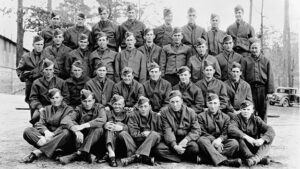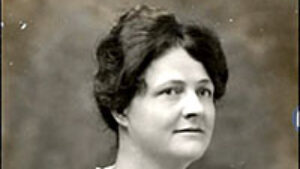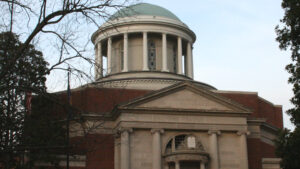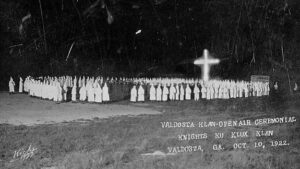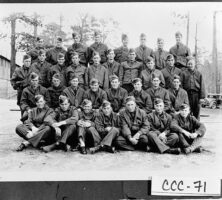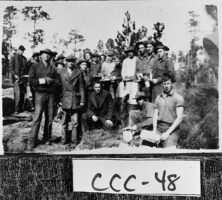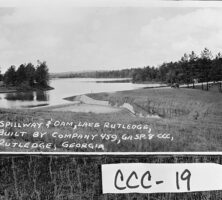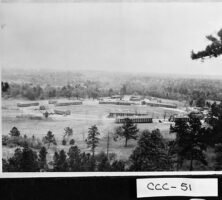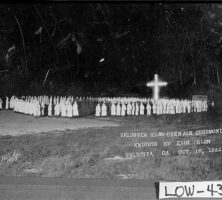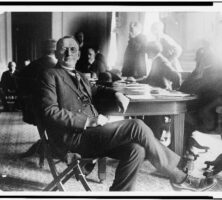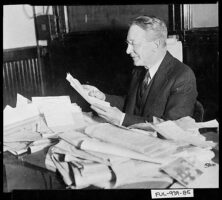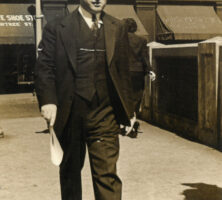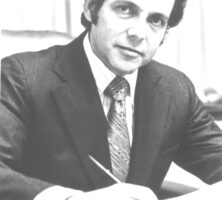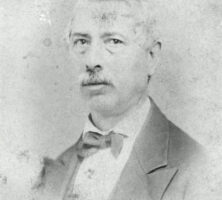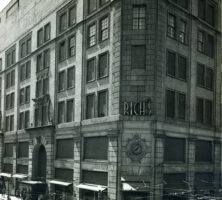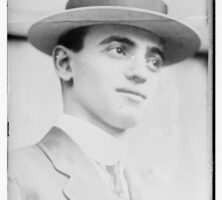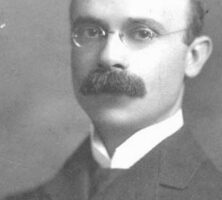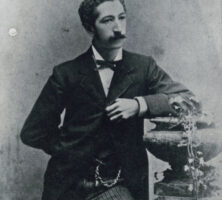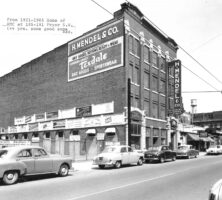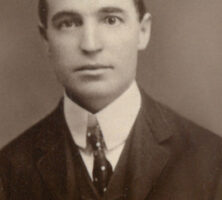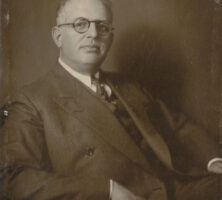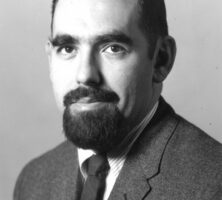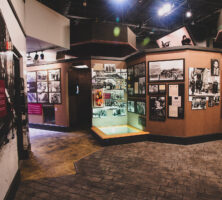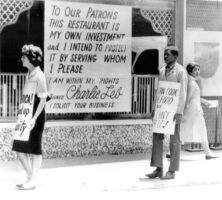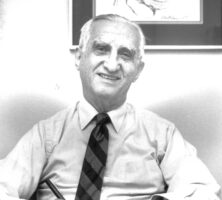The New Georgia Encyclopedia is supported by funding from A More Perfect Union, a special initiative of the National Endowment for the Humanities.
Civilian Conservation Corps members assigned to Camp Meriwether, in Meriwether County, are pictured in 1934. The camp was located near Warm Springs, where U.S. president Franklin D. Roosevelt, who instituted the CCC, came for polio treatments.
Courtesy of Georgia Archives, Vanishing Georgia, #
ccc071.
The New Georgia Encyclopedia does not hold the copyright for this media resource and can neither grant nor deny permission to republish or reproduce the image online or in print. Requests for permission to publish or reproduce the resource should be submitted to the Georgia Archives.
A Civilian Conservation Corps (CCC) work detail group is shown in Reidsville (Tattnall County) in 1935. During the Great Depression, New Deal programs like the CCC helped put thousands of Georgians back to work.
Courtesy of Georgia Archives, Vanishing Georgia, #
ccc048.
The New Georgia Encyclopedia does not hold the copyright for this media resource and can neither grant nor deny permission to republish or reproduce the image online or in print. Requests for permission to publish or reproduce the resource should be submitted to the Georgia Archives.
The spillway and dam at Lake Rutledge in Morgan County, pictured in 1935, was constructed by a Civilian Conservation Corps company.
Courtesy of Georgia Archives, Vanishing Georgia, #ccc019.
The New Georgia Encyclopedia does not hold the copyright for this media resource and can neither grant nor deny permission to republish or reproduce the image online or in print. Requests for permission to publish or reproduce the resource should be submitted to the Georgia Archives.
Civilian Conservation Corps barracks are pictured circa 1935 at Vogel State Park, near Blairsville in Union County. During the 1930s the CCC built cabins and trails at state parks around Georgia that are still in use today.
Courtesy of Georgia Archives, Vanishing Georgia, #
ccc060.
The New Georgia Encyclopedia does not hold the copyright for this media resource and can neither grant nor deny permission to republish or reproduce the image online or in print. Requests for permission to publish or reproduce the resource should be submitted to the Georgia Archives.
A Civilian Conservation Corps camp is pictured in 1939 from the top of Kennesaw Mountain, in Cobb County. The CCC performed historic preservation work at both the Kennesaw Mountain and Chickamauga battlefields during the 1930s.
Courtesy of Georgia Archives, Vanishing Georgia, #
ccc051b.
The New Georgia Encyclopedia does not hold the copyright for this media resource and can neither grant nor deny permission to republish or reproduce the image online or in print. Requests for permission to publish or reproduce the resource should be submitted to the Georgia Archives.
Members of the Ku Klux Klan in Valdosta gather around a burning cross during a ceremony in October 1922. That same year Hiram W. Evans of Texas assumed leadership of the Klan and worked to extend its political influence across the country, including in Georgia.
Courtesy of Georgia Archives, Vanishing Georgia, #
low043.
The New Georgia Encyclopedia does not hold the copyright for this media resource and can neither grant nor deny permission to republish or reproduce the image online or in print. Requests for permission to publish or reproduce the resource should be submitted to the Georgia Archives.
William J. Simmons, seated during a 1921 investigation of the Ku Klux Klan by a U.S. House of Representatives committee, was inspired by D. W. Griffith's film, The Birth of a Nation, and the Leo Frank trial in Atlanta to reestablish the Klan in 1915. Simmons designed the hooded uniforms and secret rituals associated with the organization.
Courtesy of Library of Congress, Prints and Photographs Division
The New Georgia Encyclopedia does not hold the copyright for this media resource and can neither grant nor deny permission to republish or reproduce the image online or in print. All requests for permission to publish or reproduce the resource must be submitted to the rights holder.
Julian Harris, editor and co-owner, with his wife, Julia, of the Columbus Enquirer-Sun, reads mail at his desk in the late 1920s. Harris, the son of Georgia folklorist Joel Chandler Harris, and his wife jointly won a Pulitzer Prize in 1926 for their reporting in the Enquirer-Sun on state officials with ties to the Ku Klux Klan.
Courtesy of Georgia Archives, Vanishing Georgia, #
ful0939-85.
The New Georgia Encyclopedia does not hold the copyright for this media resource and can neither grant nor deny permission to republish or reproduce the image online or in print. Requests for permission to publish or reproduce the resource should be submitted to the Georgia Archives.
Before founding the Association of Southern Women for the Prevention of Lynching (ASWPL), Jessie Ames was president of the Texas League of Women Voters and director of women's work for Atlanta's Commission on Interracial Cooperation. As part of her work with the ASWPL, Ames formed alliances with Jewish women's groups, the Young Women's Christian Association, and the Parent-Teacher Association.
Courtesy of Austin History Center, Austin Public Library, FP E.4 D #9
The New Georgia Encyclopedia does not hold the copyright for this media resource and can neither grant nor deny permission to republish or reproduce the image online or in print. All requests for permission to publish or reproduce the resource must be submitted to the rights holder.
John Hope, the first Black president of both Morehouse College and Atlanta University (later Clark Atlanta University), was an important African American educator and race leader of the early twentieth century.
Image from The Crisis, Vol 8, No 1, May 1914
The New Georgia Encyclopedia does not hold the copyright for this media resource and can neither grant nor deny permission to republish or reproduce the image online or in print. All requests for permission to publish or reproduce the resource must be submitted to the rights holder.
The Hebrew Benevolent Congregation, which first organized in 1860 as the Hebrew Benevolent Society, began construction in 1875 on a synagogue in Atlanta. The Temple, as it came to be known, continues to serve the Jewish community in the city.
Photograph by David
The New Georgia Encyclopedia does not hold the copyright for this media resource and can neither grant nor deny permission to republish or reproduce the image online or in print. All requests for permission to publish or reproduce the resource must be submitted to the rights holder.
In 1928 Edward Kahn became the executive director of the Federation of Jewish Charities. The federation was formed in 1905 to help new Jewish immigrants adjust to life in the United States, and the organization later became a charter member of the Community Chest.
The New Georgia Encyclopedia does not hold the copyright for this media resource and can neither grant nor deny permission to republish or reproduce the image online or in print. All requests for permission to publish or reproduce the resource must be submitted to the William Breman Jewish Heritage Museum.
Sam Massell was elected mayor of Atlanta in 1969, the first Jew to hold that office in the city. Massell's uncle was Ben Massell, one of Atlanta's premier builders and developers during the mid-twentieth century.
The New Georgia Encyclopedia does not hold the copyright for this media resource and can neither grant nor deny permission to republish or reproduce the image online or in print. All requests for permission to publish or reproduce the resource must be submitted to the William Breman Jewish Heritage Museum.
During the antebellum period in Atlanta, most Jews supported the Confederacy, including David Mayer. Mayer served as Governor Joseph E. Brown's commissary officer, and later became a founding and longtime member of Atlanta's school board.
The New Georgia Encyclopedia does not hold the copyright for this media resource and can neither grant nor deny permission to republish or reproduce the image online or in print. All requests for permission to publish or reproduce the resource must be submitted to the William Breman Jewish Heritage Museum.
In 1924 Rich's Department Store opened its flagship store in downtown Atlanta, where it remained until 1991. The building was remodeled during the late 1990s and became part of the Sam Nunn Atlanta Federal Center.
The New Georgia Encyclopedia does not hold the copyright for this media resource and can neither grant nor deny permission to republish or reproduce the image online or in print. All requests for permission to publish or reproduce the resource must be submitted to the William Breman Jewish Heritage Museum.
Leo Frank, the superintendent of the National Pencil Company in Atlanta, was convicted of the murder of factory worker Mary Phagan in 1913. Frank was lynched by a mob in Marietta in 1915 after Governor John M. Slaton commuted Frank's death sentence to life imprisonment.
Courtesy of Library of Congress, Prints and Photographs Division
The New Georgia Encyclopedia does not hold the copyright for this media resource and can neither grant nor deny permission to republish or reproduce the image online or in print. All requests for permission to publish or reproduce the resource must be submitted to the rights holder.
David Marx was a longtime rabbi at "the Temple" in Atlanta. He led the move toward Reform Judaism practices, which were more acceptable to middle-class America. Marx also encouraged his women congregants to form a local section of the National Council of Jewish Women.
The New Georgia Encyclopedia does not hold the copyright for this media resource and can neither grant nor deny permission to republish or reproduce the image online or in print. All requests for permission to publish or reproduce the resource must be submitted to the William Breman Jewish Heritage Museum.
In 1875 Aaron Haas became Atlanta's first mayor pro tempore.
The New Georgia Encyclopedia does not hold the copyright for this media resource and can neither grant nor deny permission to republish or reproduce the image online or in print. All requests for permission to publish or reproduce the resource must be submitted to the William Breman Jewish Heritage Museum.
Hyman Mendel's dry-goods store, 1921. Mendel, part of a wave of Jewish immigrants from eastern Europe who arrived in Atlanta in the 1880s, became the city's biggest dry-goods wholesaler.
The New Georgia Encyclopedia does not hold the copyright for this media resource and can neither grant nor deny permission to republish or reproduce the image online or in print. All requests for permission to publish or reproduce the resource must be submitted to the William Breman Jewish Heritage Museum.
Hyman Mendel was one of many successful Jewish immigrants in Atlanta. Mendel became the city's biggest dry-goods wholesaler by the turn of the twentieth century.
The New Georgia Encyclopedia does not hold the copyright for this media resource and can neither grant nor deny permission to republish or reproduce the image online or in print. All requests for permission to publish or reproduce the resource must be submitted to the William Breman Jewish Heritage Museum.
In 1936 the Coca-Cola Company attorney Harold Hirsch helped reorganize Atlanta's Jewish social service agencies. The political climate in the United States and in Germany during the 1930s resulted in a switch in priorities to overseas relief.
The New Georgia Encyclopedia does not hold the copyright for this media resource and can neither grant nor deny permission to republish or reproduce the image online or in print. All requests for permission to publish or reproduce the resource must be submitted to the William Breman Jewish Heritage Museum.
Rabbi Emanuel Feldman led the congregants of Orthodox Congregation Beth Jacob during the 1950s. The creation of the congregation served as a harbinger of the cermonial/religious revival of the last half of the twentieth century.
The New Georgia Encyclopedia does not hold the copyright for this media resource and can neither grant nor deny permission to republish or reproduce the image online or in print. All requests for permission to publish or reproduce the resource must be submitted to the William Breman Jewish Heritage Museum.
The permanent exhibit The Holocaust Years at the William Breman Jewish Heritage Museum in Atlanta describes the systematic murder of 6 million European Jews by the Nazis and their collaborators. The story is told through photographs, documents, personal memorabilia, family pictures, and in the voices of those who survived and made new lives in Atlanta.
The New Georgia Encyclopedia does not hold the copyright for this media resource and can neither grant nor deny permission to republish or reproduce the image online or in print. All requests for permission to publish or reproduce the resource must be submitted to the William Breman Jewish Heritage Museum.
When Leb's delicatessen, a Jewish-owned business in Atlanta, was singled out by sit-in demonstrators during the early 1960s, it became a symbol of recalcitrance.
The New Georgia Encyclopedia does not hold the copyright for this media resource and can neither grant nor deny permission to republish or reproduce the image online or in print. All requests for permission to publish or reproduce the resource must be submitted to the William Breman Jewish Heritage Museum.
Max Gettinger oversaw the reorganization of the Federation of Jewish Charities in 1967. The federation, which began in 1905, was one of many organizations that were formed to cater to the social-service, as well as social, needs of the immigrant Jewish community in Atlanta.
The New Georgia Encyclopedia does not hold the copyright for this media resource and can neither grant nor deny permission to republish or reproduce the image online or in print. All requests for permission to publish or reproduce the resource must be submitted to the William Breman Jewish Heritage Museum.
